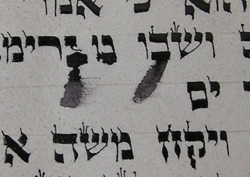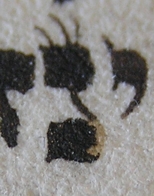
"God," says Moses, "'sup? You don't need these!"
"Aha," God replies, "but after many generations, a scholar by the name of Rabbi Akiva will arise who will derive from them mountains of laws."
Mount Sinai is the original Mountain of Law, and on top of the Mountain of Law are squillions of crowns which are all themselves mountains of law, and so ad infinitum. I'm sure there's a spiritual word for "fractal," but I can't think of it at the moment - anyway, it suggests the move from the first mountain, the physical realm, into the mountains beyond, the metaphysical realm.
Sefer Yetzirah (trans. Aryeh Kaplan; 3:7) says These crowns represent the higher spiritual nature of the letters. If the letters themselves are in Assiyah, then the crowns on top bind them to Yetzirah - that is, if the letters are in the lowest sphere of existence, the physical world, the crowns form the link into the next sphere of existence, that which shapes the physical world.
 The letters shin, ayin, tet, nun, zayin, gimel, and tzaddi are the ones with crownlets. Actually, what the Talmud says is that these letters are zayinified (שבעה אותיות צריכות שלשה זיונין, ואלו הן: שעטנ"ז ג"ץ), and indeed the crownlets approximately resemble zayins, being a little stick with a lump on the top, which fundamentally is what makes zayin. Of course if you put zayins on a letter, the zayins have zayins, and so on, which is why I made the animation at right. (Heh. I've been wanting to do that for ages.)
The letters shin, ayin, tet, nun, zayin, gimel, and tzaddi are the ones with crownlets. Actually, what the Talmud says is that these letters are zayinified (שבעה אותיות צריכות שלשה זיונין, ואלו הן: שעטנ"ז ג"ץ), and indeed the crownlets approximately resemble zayins, being a little stick with a lump on the top, which fundamentally is what makes zayin. Of course if you put zayins on a letter, the zayins have zayins, and so on, which is why I made the animation at right. (Heh. I've been wanting to do that for ages.)Part of the kabbalistic apparatus is the set of sefirot, the divine levels of understanding. The ultimate one is Infinity, the utterly-unknowable-unless-you're-God, then you get revelation and understanding (the intellectual realm, apparently), then a bunch of things like mercy and grace (the emotive realm), but this is a very bald rendering and properly it is terribly nuanced and subtle. And there are ten altogether.
Zayin is the seventh letter in the alef-bet, and it has three taggin. That makes ten sefirot! So one interpretation of a zayin is that the seven part, underneath, corresponds to the seven sefirot in the emotive realm, and the three part, the three higher.
In which case, the three taggin correspond to Keter (Infinity), Hokhmah (Wisdom), and Binah (Love). The middle one is the tallest, and represents Keter, which is the highest possible state of being; Hokhmah is the next tallest and the next most important so it sits on the right, and Binah is the shortest and sits on the left (Understanding the Alef-Beis, Dovid Leitner).
Talking of wisdom and understanding, what was the deal with Rabbi Akiva earlier? Rabbi Akiva represents a period in rabbinic history when scholars were looking at the day-to-day Judaism which had evolved with the societies it was part of, noting that in some places it didn't much resemble the original Torah, and doing something about that. To wit, tracing the exegetical paths that ran between the Torah and the current Judaism. Depending on your attitude towards rabbinics, you may find this more or less evidence-of-divine-planning or contrived-post-facto - logical processes leading to everything we do or customs given authenticity by retroactive and unlikely links to biblical authority. It doesn't really matter; whichever way you swing, Rabbi Akiva and his successors were engaged in an activity that shaped Judaism. That's not relevant to crownlets per se, except that it was an activity directed at Keter which required Hokhmah and Bina...anyway, I like it.












